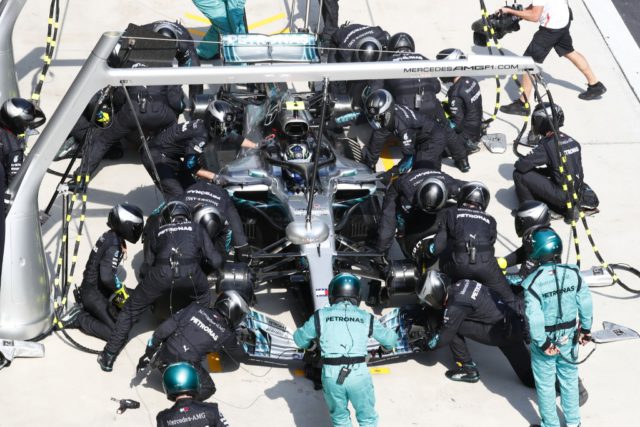It’ll take longer for you to read this sentence than it takes a Formula One team to complete a pit stop. That’s how quick modern-day tyre changes are. Well, at least in theory – if you change the tyre choice last minute, it can take slightly longer… Mercedes explains the secrets of the perfect pit stop.
What is the most important factor for a good pit stop?
Achieving the perfect F1 pit stop is far from easy. It requires all of its intricate elements to be working in absolute harmony. This is a tough task, particularly when the pit stop falls in the midst of a tense on-track battle. Cars arrive and depart in a little over two seconds. Well, that’s the aim, anyway. Anything over that mark is considered a ‘slow stop’, which is remarkable when you think about the amount of activity that happens in such a short space of time.
Outright speed, however, is actually not the most important goal for the team – instead, it’s all about consistency. A 1.9-second stop is great. But if you follow that up later in the race with a 3.6-second tyre change that advantage is lost. Teams are looking for their pit stop times to be consistent across not only individual races but the season as a whole.
What exactly do the individual crew members do in a pit stops?
Within the tight timeframe of an F1 pit stop, the first step is the car coming into the box and stopping on the marks. One crew member will be holding a stop board, indicating where exactly the front tyre should come to a stop. Once the car has reached its position, the sign will go up. It will then be lifted up by the people operating the front and rear jacks. It’s at this point that the tyre crew get to work.
There are twelve people involved in changing the tyres, three on each of the car’s four corners. One operates the wheel gun, one takes the old tyre off and another places the new tyre on. Once the wheel nuts have been loosened, the worn tyres are taken off and new ones are then fitted. The wheel nuts are tightened. If the crew members are happy that they are safely on, they will hit a button on their wheel guns to confirm this.
While this is going on, there are two crew members positioned at the front of the car to adjust the front wing flags, using electrically-operated guns. There are also two placed in the middle of the car, to steady it on the jacks, clear the radiators and clean the driver’s visor and mirrors when required. Another team member is overseeing the pit stop and the pit lane traffic. This person has the final say as to whether the traffic light gantry system goes green, which releases the driver into the fast lane. If there’s too much traffic, they’ll keep holding down their button until a gap emerges.
How long do the individual tasks take?
It’s tricky to break down just how long each element takes, because it goes by so quickly. But, from the car stopping on its marks to the wheel nut being taken off is around five tenths of a second. From there, you need another second for the tyre change and securing it back on is roughly four tenths. Dropping the car takes around two tenths. But, of course, this all depends on whether everything goes to plan.

How does the pit crew practice for pit stops?
Naturally, with so much focus on consistency and the need for all of these people to be working in synchronisation, practice most definitely makes perfect. The team completes around 60 practice pit stops over the course of the race weekend. On Thursday, there’s always a change-around, where people swap roles for a few of the stops. Every member of the pit crew has his set role. And these are usually kept the same throughout the course of a season.
But, people have experience in different tasks, so a change-around can take place if necessary. And the team doesn’t just run through normal, everyday scenarios. They’re also practising possible situations that may come up. Like changing a nose (which requires a special side-jack), switching to the spare wheel guns or using the starter motor if the car stalls. To make sure that the pit stops are as consistent as possible from the very first race of the season on, the team does about 60 pit stops per week during pre-season.
What else can a team do to get faster pit stops?
In addition to trying to prepare for most scenarios, there’s a constant drive for improvement – from the positioning of the crew to the equipment itself (such as the wheel nut design). Fitness is another way to enhance pit stops and the team work hard in the gym to be in the best shape possible. The main focus is on strength, conditioning training and stretching, but there’s also training specific to the different roles.
A second @DHL_Motorsports Fastest Pit Stop Award of 2018 for @ScuderiaFerrari at Hockenehim ⏱️ #GermanGP ?? #F1 pic.twitter.com/lf8w0GOWPw
— Formula 1 (@F1) July 22, 2018

































